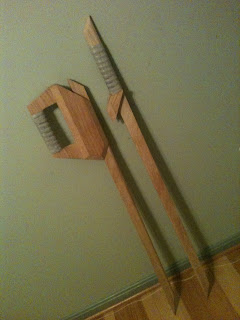I improvised these from discarded bedslats. That's my first shield, and I'll be testing its durability to make sure it's safe to use and see how long it lasts. These are made of pine, so they won't be as strong or last as long as any made from oak.
I also made the shield reversible by not fastening the handle to either set of outcroppings on the back. It can be slid up through a large, then a small, hole in those outcroppings. I haven't put a strap on either side of it, either, because I'd like to see more how it handles with the greater maneuverability. I might put straps on it later, though.
The shield also has a hollow track going all the way through it (an inadvertent result of the design, which was itself just accounting for the soft materials I had). I'm in the process of making a dirk that can be stowed in that track, for the purpose of backup armament in case of disarming and any other badass ideas you can think of. I'll post a picture when that's done.





